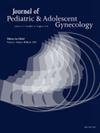25. Correlation of serum inhibin B and radiographic hemorrhagic cyst: A case for conservative management
IF 1.8
4区 医学
Q3 OBSTETRICS & GYNECOLOGY
引用次数: 0
Abstract
Background
Ovarian neoplasms occur 2.6 per 100,000 in the child and adolescent population and are usually benign in nature. The incidence of pediatric ovarian malignancy is poorly understood, as it is exceedingly rare, though when present, adnexal masses are diagnosed as gynecologic malignancy 3-8% of the time. Tumors markers like inhibins can be used to differentiate between benign and malignant lesions. Inhibin B is generally thought to be elevated in granulosa cell malignancies and can be a cause of primary or secondary amenorrhea. No literature, however, has demonstrated an association with an elevation of inhibin B with benign pathologies as discussed in this case.
Case
A 12-year-old female presented to pediatric gynecology with a left adnexal mass incidentally noted on renal ultrasound while undergoing evaluation for pediatric hypertension. Menarche occurred at age 11 with regular monthly cycles. An abdominal ultrasound and CTAP were notable for a 5.3 × 4.9 × 4.2cm thin walled cyst in left ovary concerning for hemorrhagic cyst. Labs demonstrated normal estradiol, testosterone, aldosterone, bHCG, inhibin A, and AFP. Inhibin B was elevated to 464. Given patient age and reassuring findings on ultrasound, it was ultimately decided to trend serum inhibins, mass size with ultrasound, and consult pediatric surgery given possible gynecologic malignancy. Repeat imaging 4 weeks later showed a stable hemorrhagic cyst and down trending inhibin B at 180. At 8 weeks from onset, imaging demonstrated interval resolution hemorrhagic cyst and inhibin B at 118. Given the improvements, repeat imaging and inhibin was obtained five months later with no evidence of recurrence of hemorrhagic cyst and normalized inhibin B at 35.
Comments
Limited data exists regarding conservative treatment of adnexal masses that are benign in nature in the setting of elevated tumor markers in pediatric and adolescent patients. In this case, a benign appearing lesion was associated with elevations of inhibin B, which raised concern for gynecologic malignancy. In absence of high-risk ultrasonographic features or symptoms of hyperestrogenism that one would expect in juvenile granulosa cell tumor, the clinical picture was consistent with benign pathology. Thus, inhibin was trended to normal range and correlated with simultaneous resolution of the cyst. An unnecessary surgical procedure was avoided in this asymptomatic patient. Further studies need to be collected to validate the use of trending inhibin B in the setting of benign adnexal pathologies like hemorrhagic cysts.
25.血清抑制素 B 与影像学出血性囊肿的相关性:一个需要保守治疗的病例
背景:在儿童和青少年人群中,每10万人中就有2.6例发生卵巢肿瘤,通常是良性的。小儿卵巢恶性肿瘤的发病率知之甚少,因为它是非常罕见的,尽管当存在附件肿块时,3-8%的时间被诊断为妇科恶性肿瘤。抑制素等肿瘤标志物可用于区分良性和恶性病变。抑制素B通常被认为在颗粒细胞恶性肿瘤中升高,可能是原发性或继发性闭经的原因。然而,没有文献表明抑制素B的升高与本病例所讨论的良性病理有关。病例:一名12岁女性在接受小儿高血压评估时,在肾脏超声检查中偶然发现左附件肿块。初潮发生在11岁,月经周期有规律。腹部超声及CTAP示左侧卵巢5.3 × 4.9 × 4.2cm薄壁囊肿,提示出血性囊肿。实验室显示雌二醇、睾酮、醛固酮、bHCG、抑制素A和AFP正常。抑制素B升高至464。考虑到患者的年龄和超声检查结果,最终决定用超声检查血清抑制素、肿块大小,并考虑到可能的妇科恶性肿瘤,咨询儿科外科医生。4周后复查显示出血性囊肿稳定,抑制素B值180呈下降趋势。发病后8周,影像学显示出间期溶解性出血性囊肿和抑制素B值为118。鉴于改善,5个月后复查影像学和抑制素检查,出血性囊肿无复发迹象,35岁时抑制素B正常。评论:在儿童和青少年患者肿瘤标志物升高的情况下,关于良性附件肿块的保守治疗的数据有限。在本例中,良性病变与抑制素B升高有关,这引起了对妇科恶性肿瘤的关注。在没有高危超声特征或高雌激素分泌症状的情况下,预期在青少年颗粒细胞瘤中,临床表现与良性病理一致。因此,抑制素趋向于正常范围,并与囊肿的同时溶解相关。该无症状患者避免了不必要的手术。需要进一步的研究来验证趋势抑制素B在良性附件病变(如出血性囊肿)中的应用。
本文章由计算机程序翻译,如有差异,请以英文原文为准。
求助全文
约1分钟内获得全文
求助全文
来源期刊
CiteScore
3.90
自引率
11.10%
发文量
251
审稿时长
57 days
期刊介绍:
Journal of Pediatric and Adolescent Gynecology includes all aspects of clinical and basic science research in pediatric and adolescent gynecology. The Journal draws on expertise from a variety of disciplines including pediatrics, obstetrics and gynecology, reproduction and gynecology, reproductive and pediatric endocrinology, genetics, and molecular biology.
The Journal of Pediatric and Adolescent Gynecology features original studies, review articles, book and literature reviews, letters to the editor, and communications in brief. It is an essential resource for the libraries of OB/GYN specialists, as well as pediatricians and primary care physicians.

 求助内容:
求助内容: 应助结果提醒方式:
应助结果提醒方式:


